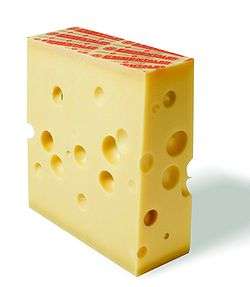Eyes (cheese)

Eyes are the round holes that are a characteristic feature of Swiss-type cheese[1] (e.g. Emmentaler cheese) and some Dutch-type cheeses. They are bubbles of carbon dioxide gas that is produced by bacteria in the cheese.
Swiss cheese
In Swiss-type cheeses, the eyes form as a result of the activity of propionic acid bacteria (propionibacteria), notably Propionibacterium freudenreichii subsp. shermanii.[2][3] These bacteria transform lactic acid into propionic acid and carbon dioxide, according to the formula:
The CO2 so produced accumulates at weak points in the curd, where it forms the bubbles that become the cheese's eyes.[2] Not all CO2 is so trapped: in an 80 kg (180 lb) cheese, about 20 L CO2 remain in the eyes, while 60 L remain dissolved in the cheese mass and 40 L are lost from the cheese.[1]
Dutch cheese
In Dutch-type cheeses, the CO2 that forms the eyes results from the metabolisation of citrate by citrate-positive ("Cit+") strains of lactococci.[5]
Bibliography
- Polychroniadou, A. (2001). Eyes in cheese: a concise review. Milchwissenschaft 56, 74-77.
References
- Fox, P.F. (ed.). Cheese: Chemistry, Physics, and Microbiology, Volume 1: General Aspects. Academic Press. ISBN 978-0-12-263652-3.
Footnotes
- 1 2 P.L.H. McSweeney and P.R Fox; Metabolism of Residual Lactose and of Lactate and Citrate, in: Fox, p. 366
- 1 2 P.L.H. McSweeney, Biochemistry of Cheese Ripening: Introduction and Overview, in: Fox, p. 349
- ↑ "Propionibacterium freudenreichii ssp shermanii ATCC9614: A bacterium used in the production of Emmental". Genoscope. 16 January 2008. Retrieved 23 October 2010.
- ↑ T. Beresford, A. Williams; The Microbiology of Cheese Ripening, in: Fox, p. 303
- ↑ P.L.H. McSweeney and P.R Fox; Metabolism of Residual Lactose and of Lactate and Citrate, in: Fox, p. 367